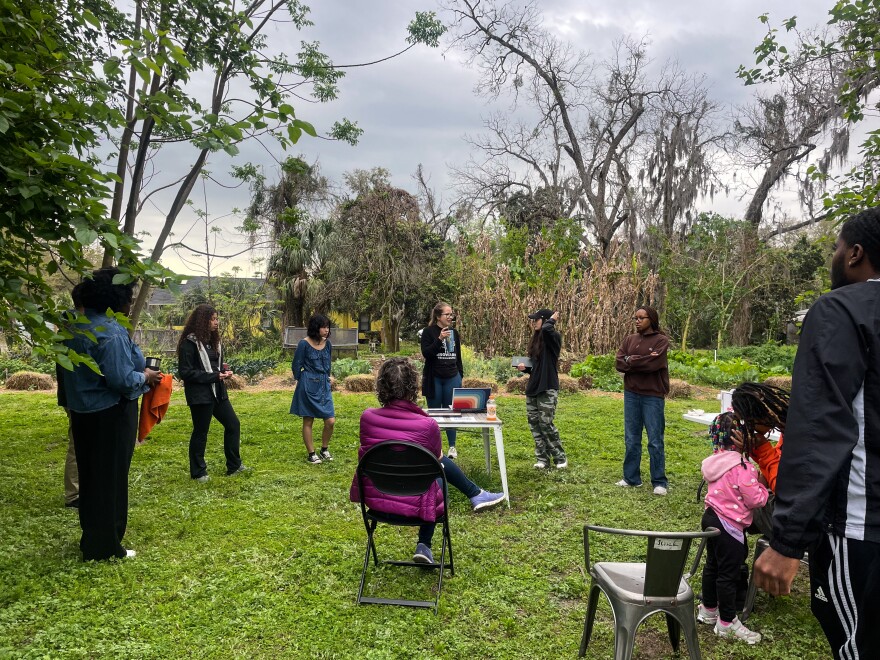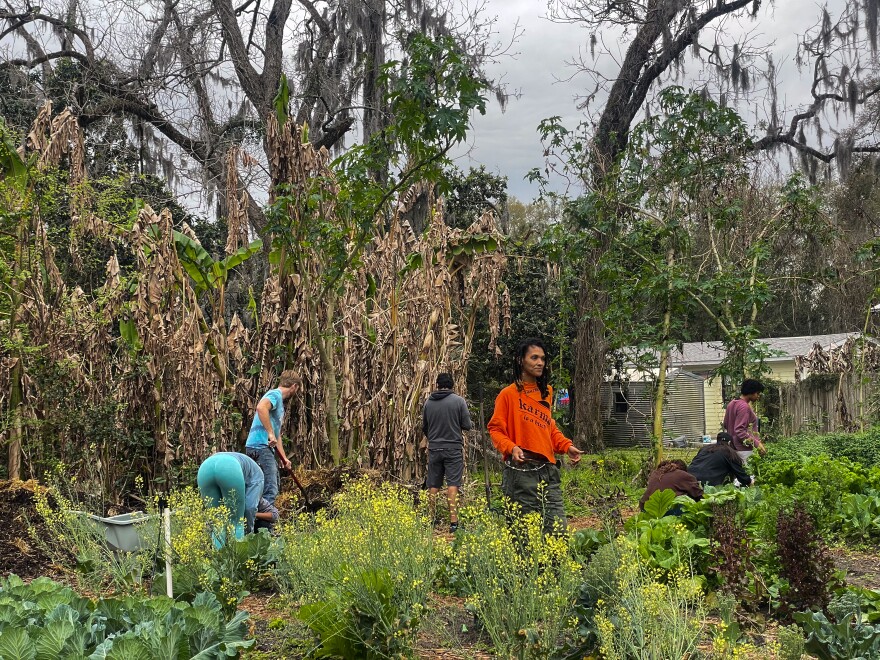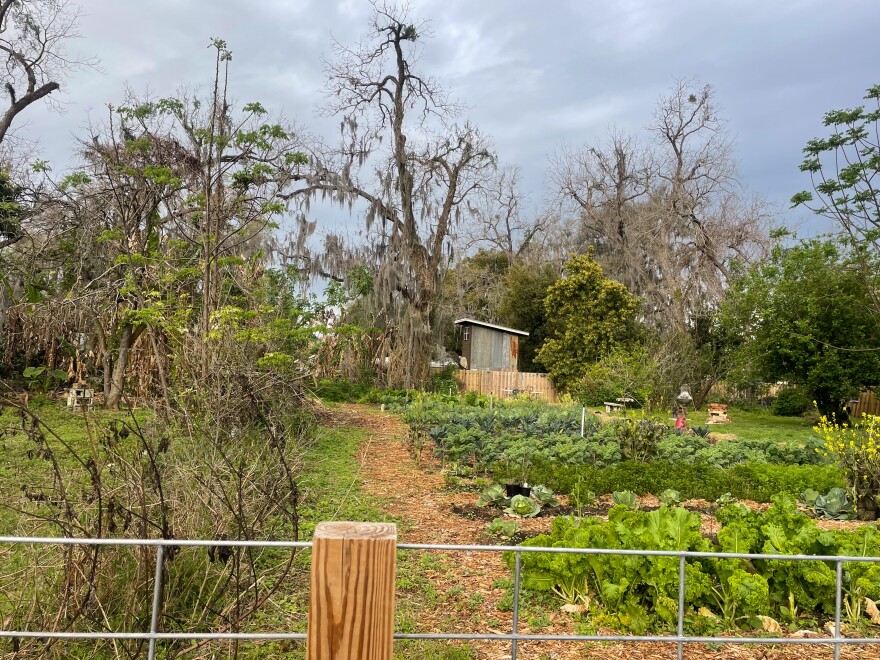The clouds of rain and early morning wake-up call were no match for the group gathering Saturday at Porters Community Farm.
Trickling in few by few, people formed into a circle, eager to share their thoughts on an issue impacting their home. It marked the start of an event two years in the making.
“I’m really feeling great about today,” said Rhiannon O’Donnell, a senior at the University of Florida. “I was super nervous going into it because it has been a product of years of work and it’s a little bit intimidating to present it to people.”
The event, held Saturday morning, marked the launch of Florida Community Innovation’s Gentrification Risk Assessment Tool. O’Donnell, a data science major, has been developing it since 2023.
“I was on an excursion for a class to the A. Quinn Jones Museum and we were having a conversation with a lifelong Gainesville citizen,” O’Donnell said. “They were telling us firsthand about their experience with gentrification…and that made me want to explore that.”
A grant from the Bob Graham Center for Public Service helped initially fund the tool, which is designed to educate users about gentrification impacts and risks in the Gainesville community, according to its website.
O’Donnell, along with a team of other UF students, is making the resource public on the website of a a student-led nonprofit organization known as Florida Community Innovation. It’s focused on solving challenges in the state using human-centered technology. O’Donnell is a member.

The group used different statistical analysis techniques to build the tool, seeking mainly to identify three stages of gentrification: not gentrified, gentrifying and gentrified. They then organized this information into a map, highlighting which stage different parts of Gainesville are at, they said.
“This is kind of like, ‘OK, you are saying that you witnessed gentrification and you’re experiencing it,’” O’Donnell said. “Well, here’s the data behind that and here are the patterns that you are noticing.”
The launch event included a community dialogue and hands-on volunteering at the farm. While the dialogue was originally organized to share ideas about improving the GRAT, it centered more around gentrification awareness, especially among college students.
“I feel like as a UF student, you don’t have too much connection to the actual Gainesville community outside of UF,” said Zachary Sayers, a third-year UF student and member of Progressive Black Men Incorporated. “Especially the gentrification efforts that are affecting the east side of Gainesville, which a lot of students are disconnected from.”
Sayers is also a part of Florida Community Innovation and helps with some of its projects. Saturday’s event piqued his interest and he decided to attend to give back, he said.
“This one definitely caught my eye as a person of color,” he said. “It’s definitely something that concerns me, especially being a part of this community in Gainesville.”
Sayers’ acknowledgement of the issue and interest in learning more is exactly what O’Donnell intended when she built the tool. She hopes it sparks conversation about gentrification within the local community, among both students and non-students.
“The tool itself is not meant to solve gentrification,” O’Donnell said. “It’s meant to be the basis of a conversation. I do feel like a lot of people, especially those connected to UF, are a little bit oblivious as to how luxury student apartments and everything can affect the neighborhoods around them.”

Erinesha Hamilton, vice president of the Porters Quarters Community Connection Board, hopes that the event did in fact bring awareness to the issue. She believes discussions about the topic need to continue.
“I’m originally from New Orleans, Louisiana, and I left Louisiana when we experienced Katrina,” Hamilton said. “I experienced a whole city of people having to disperse and lose connections and that’s what happens when we lose our community, we lose connection.”
Students have a big role to play in this effort, according to Hamilton. She hopes more UF students can become better connected to the local community.
“I can appreciate some of the student population, especially the ones that volunteer at the farm,” she said. “I think it’s important for the city of Gainesville to give students a sense of home. When students are connected to the community, they feel like this is somewhere where I can be.”
Hamilton added that the city should work bridge students and the local community. If students feel a part of the community, she said, they may stay for longer than just their college years.
Using the thoughts shared in the group dialogue, O’Donnell and the other FCI students now have action points they plan on addressing to promote community advocacy. Some ideas discussed included sharing community history at UF Preview and including community voices in conversations surrounding the topic of gentrification.
Monique Fleming, a retired educator living in the Porters community, sees the value in integrating younger community members with the people who have been there the longest. She has seen a lot of population changes in the past five years, especially as more student housing has popped up in Porters, she said. She believes that the best way to bring the whole community, including the newcomers, together is by having fun.
“I think that having a community event that somehow draws everyone to it, whether it be an old-fashioned block party or something like that creates a lot of hype,” she said. “It can bridge the gap between the youth and other groups. We can have the college students. We can have the elders. We can have the middle age, pretty much just bringing everybody together.”
By releasing the tool, O’Donnell and her team hope to turn discussion in the Gainesville area into action.
“We weren’t just talking about like this is bad, gentrification is bad,” O’Donnell said. “It was more about what we can do to address the issues that people are facing. Now we can go to different groups and audiences and meetings and talk about it being informed and empowered.”

